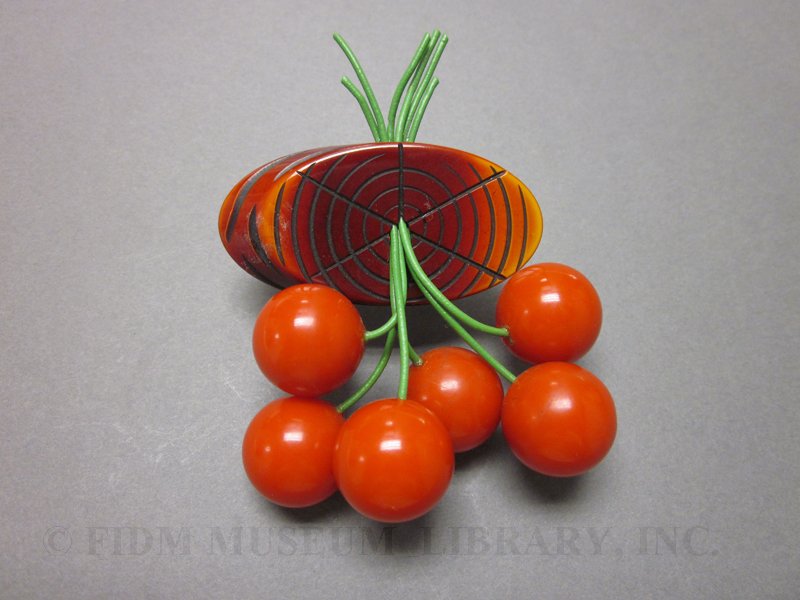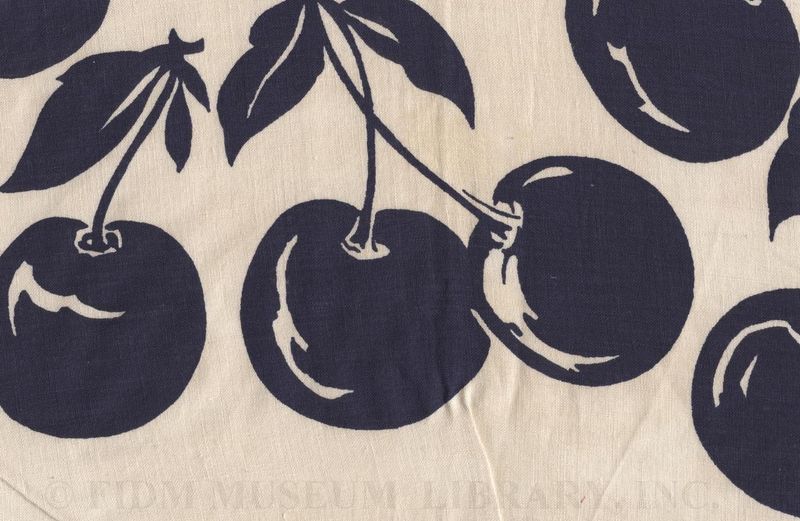 Cherry and log brooch
Cherry and log brooch
c. 1935-1940
Gift of Steven Porterfield
2010.897.49
Can you imagine a world without plastic? Overwhelmingly ubiquitous today, plastic has been in existence for less than 200 years. Prior to the last quarter of the 19th century, when plastic products became commercially available, everything was made from organic materials. Developed in the 1860s, early plastics generally replicated organic materials like tortoiseshell, ivory, wood or coral. Used to make children's toys, combs, cutlery, billiard balls, and many other functional and/or decorative objects, plastics were soon absorbed into the fabric of everyday life.
In the early 20th century, a new, more durable plastic was invented: Bakelite. In attempting to make a powerful solvent, chemist Leo Baekeland instead developed an extremely persistent chemical residue. Baekeland realized that his accidental discovery might have potential, tinkering with the formula until it became a strong, moldable, heat resistant plastic. Baekeland named the new substance after himself, announcing his discovery at the American Chemical Society conference in February 1909. Soon after this announcement, Baekeland formed the General Bakelite Company.
Moldable, resistant to heat, sunlight and chemical solvents, Bakelite was used in industrial applications and the manufacture of toys, radios, telephones and other products. Because it could be cut, polished, carved and dyed, Bakelite was the perfect material for crafting relatively inexpensive costume jewelry. Newly popular in the 1920s, costume jewelry was a fashionable, inexpensive alternative to jewelry made from gold and expensive stones. Though Bakelite jewelry was sometimes shaped and carved to resemble cut stones, during the 1930s it often took whimsical, even comic, forms. Do a quick Internet search for Bakelite jewelry and you'll find necklaces and pins shaped like bananas, oranges, apricots, scottie dogs, birds, insects and more.
Cherries, like the glossy bunch featured in the brooch above, were a particularly popular motif during the 1930s. In 1932, a report from Paris described afternoon frocks of "black silk crepe stamped with clusters of white, pale green or pale pink cherries and leaves."1 In 1935, Vogue described a Milgrim day dress of cherry printed silk, accompanied by a belt with clasp of black patent leather cherries. Cherry shaped buttons decorated children's clothing, and artificial cherries perched on women's hats.
Why cherries? French textile designers were perhaps aware of Lalique's 1923 Cerises, a carved plastic box featuring a tangle of cherries. Representations of this exuberant, cheerful fruit might have appealed to consumers wearied by the Depression. Within the United States, the popularity of cherries and cherry blossoms might have been linked to the April 1934 Washington D.C. cherry blossom festival. Celebrating Japanese-American friendship, this three-day festival was covered by national media. Because of its popularity, the festival became an annual event still celebrated today.
 Linen textile swatch
Linen textile swatch
c. 1938
Gift of Roberta Tuller
2006.865.13A
1 "Cherry Prints Fashion New Afternoon Frocks" The Washington Post 28 Feb. 1932: A5.

